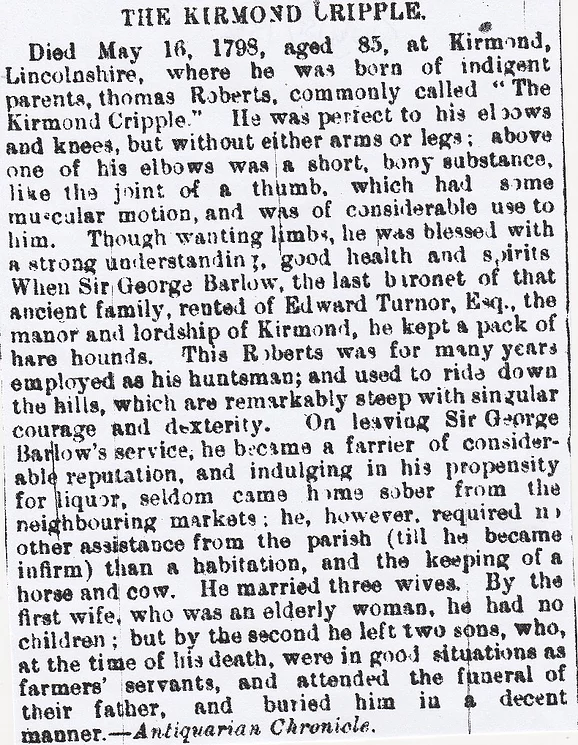1/ Hawerby Hall Murder, October 1976
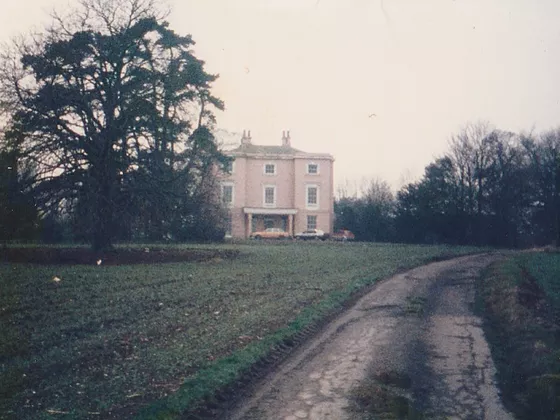
I took this picture on a £20 camera in November 1986. The murder was of 36-year-old Anthony Pulling, by his 35-year-old wife, Valerie Pulling, in October of 1976. Anthony was the son of former Scunthorpe alderman, Bill Pulling. She was allowed to stay with her parents in Wakefield on a £500 bail. Apparently, she shot him when he was getting a bit abusive. What happened in the end?
2/ Ludborough Church, February 11th, 1882 (Child Buried in Churchyard)
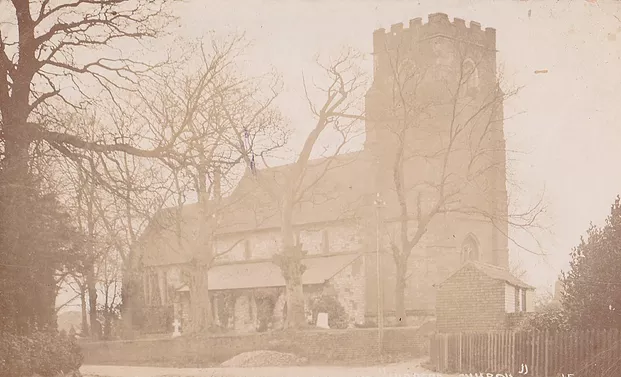
The body of a male infant was discovered in the churchyard, buried just a few inches deep. Robert Andrews the gardener and groom for the rector, Reverend Augustus Gedge, was trimming the hedge bordering on the churchyard when he spotted some fresh moulds on the grass. He examined it and found the body of the little boy beneath the soil. There were paw-prints from a dog near to the temporary grave. It seems that the body had been there for a fortnight and was that of a well-nourished boy with no marks of violence. The lungs were put into water, to determine if he had been born alive. If they floated, there was air in them, and the child had breathed. When the test was carried out, the lungs sank, so the child had not lived.
March 4th, 1882
The mystery of the child’s body in Ludborough Churchyard had a simple solution in the end. James Stanley, the sexton, denied having buried the child, and no one appeared to know anything about it. Inquiries were made by Superintendent Cadge and he found out that the sexton had been lying all along and that he had buried the body and got a death certificate from Dr George in North Thoresby. Why he concealed the burial is not known as the child was born of married people.
3/ Ludborough, March 1865 (Fatal Accident)
On Monday last an old man named White, a much-respected cottager residing in Ludborough met with his death in a shocking manner. He was engaged in assisting Mr Harrison of the Livesey Arms Inn, to load some oats in the sheaf and was riding on top of the load, when, owing to the horses stopping, he fell to the ground with the fall dislocating his neck and causing instantaneous death.
4/ Ludborough, October 1868 (Child Burns to Death)
An inquest was held in Ludborough touching the death of John William Borrell aged two years, son of a labourer in the employ of Mr Parker. It appeared that the boy had been left for only a few minutes by his mother, and on her return, she was met by the child running from the house enveloped in flames. After lingering in much agony, death took place on Tuesday.
5/ Ludborough Railway Station August 1875 (Dead Child in Box)

Shelford in Cambridgeshire, about four miles south of Cambridge.
6/ Ludborough House Drowning, August 1882
Little Rose Ellen Ayscough aged nearly two and a half years, the daughter of Mr T.W.Ayscough, of Ludborough House (on the corner of Lincoln Gate and Livesey Road), was found drowned in the pond at the front of the house. She was taken out of the pond in her father’s yard at about 8 p.m. on Saturday evening and was found to be dead. She had been in the garden with her father and he left her alone to go into the village near the house. The milkmaid just finished work, and went to wash her hands in the pond and thought she saw a doll. On returning to the house she asked if Rose was in bed and when Mrs Ayscough said no, she said: “Well, I’m afraid she’s in the pond then”. Mrs Ayscough fished the child out. “Accidentally Drowned” was the verdict.
7/ Ludborough, (Child Burnt to Death) November 1862

8/ Kelstern, (Louth/Mkt Rasen) September 1859 (Fatal Drowning)
A man and boy in the service of Mr Sharpley of Kelstern were employed in loading water from a pit. While the man was backing the horse to the edge of a deep part of the pit, the animal reared and plunged, throwing them both in the water. The man scrambled out but the boy went to the bottom and was never seen to rise. Before he could get out, life was extinct. The boy was only fourteen years of age.
9/ Kelstern, April 1871 (Fatal Horse Accident)
As you will see this is the first of three fatal accidents that occurred in this little village, of a population of around 200-230, within a seven-year range. This involved James Larder, aged seventy-four, who went to David Briggs’s farm to get some oats to sow his land with. A horse had been lent to him for the purpose and being accompanied by a young boy. Larder climbed up on the horse and sat partly on the sack, which was used for oats. The horse kicked as the went through a gate and threw him off, with his foot entangled in the gearing and the horse dragged him for a considerable distance. The boy went to get help and Mr Briggs’s shepherd was first on the scene and he stopped the horse. The old man was frightfully bruised and battered and was taken home a distance of about half a mile away. A doctor was sent for and stimulants were given to revive him but he had breathed his last.
10/ Kelstern, April 1873 (Gun Fatality)
Jon Hall aged fourteen, died as a result of injuries received by the accidental discharge of a gun he had in his possession while tenting birds in a field at Kelstern on March 19th. Charles Borman was harrowing a field and Hall came up with a gun. He heard the gun go off and turned around, saw the deceased jumping about and he thought he was larking about. He shouted out that he’d blown his arm off and then he spotted his coat was on fire from the powder, which was immediately put out. He then walked home to Coates Grange to get attention. He leaned on the gun and it discharged accidentally. In February he cut his thumb end off in a turnip cutter. He was taken to Louth Hospital and was doing well for a week or two, then lock-jaw set in and he died soon after.
11/ Kelstern Fatal Accident, April 1866
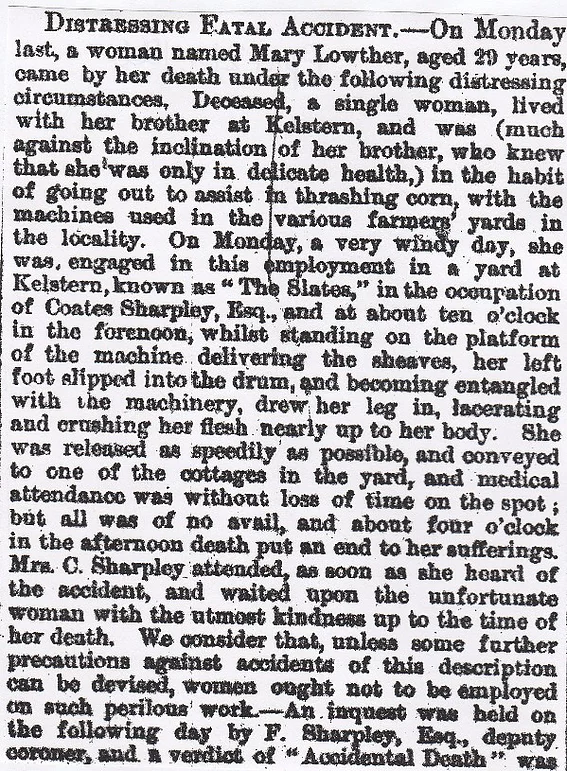
12/ Kelstern, December 1873
At Kelstern, an aged widow named Susan Taylor who had been infirm for some time retired to rest as usual. Her grand-daughter who slept with her, on waking the next morning at seven a.m., found her in a calm sleep and after dressing and making up a fire she went to call her granny but was alarmed to find her dead. Deceased was under the care of Dr Fawcett of Binbrook who was sent for, and said that death was from natural decay, she was eighty-four years old,
13/ Kelstern, August 1880 (Gored to Death by Bull)
Another freaky death in Kelstern, which must rate as one of the most dangerous places to live in Victorian Lincolnshire! Wright Hall, aged about sixty-five years, was gored to death by a bull in a field in Kelstern. He was alone with the animal and it didn’t seem too vicious. Hall struck it once or twice with a stick and it seemed to shy away when Hall came near. The bull attacked him, mangling and mutilating him in a shocking manner and breaking all of his ribs. Deceased was leading the bull, which was about four years old from his stable to a field. After the tragedy, the bull was shot. “Accidental Death”.
14/ Grainsby Motorcycle Death, September 1903
James Edward Robinson, a twenty-three-year-old valet in service in Aberia, was involved in a fatal cycling accident at Grainsby. The motorcycle skidded and Robinson was thrown off. The poor chap landed on his head and the doctor confirmed at the inquest, that his death was caused by the breaking of his neck.
15/ Grimoldby Suicide, November 1868
On Friday morning, Thomas Ellerby, a farmer at Grimoldby, committed suicide by cutting his throat. He was not dead when discovered and medical aid was sent from Louth but shortly after the arrival of J.Nelthorpe, surgeon, he expired. Deceased had been in a very desponding state of mind for some time.
16/ Kirmond-le-Mire Cripple, April 1895
17/ Great Limber Fatal Accident, (Grimsby/Brigg) June 1859
An inquest on the body of a thirty-four-year-old labourer, Edward Symonds was held at Limber. On May 26th he was sent with a water cart to a seed field, and had been cautioned against riding on the cart between certain gates but neglecting the caution he was thrown off. He landed on his head and received an injury which brought on concussion and effusion of the brain. He slipped into a coma for about a week, then passed away.
18/ Hallington (Louth), March 1873 (Crushed by Bull)
John Kirby aged sixty years, who had been working for William Chatterton of Hallington for about seven or eight years as a garthman, received such severe injuries from a bull, which terminated fatally. The beast was not a vicious one but it knocked down the old man then knelt upon him and crushed him. A fork had to be stuck in the bull’s neck to get him to move, and when extricated he was found to have massive internal injuries with several broken ribs. He received medical aid and lingered for two days, then expired.
19/ Grasby near Caistor, April 1906 (Policeman Under Arrest)
A bizarre tale of Henry Gabitass, a 25-year-old policeman, whose beat was in the village of Grasby. He had a massive argument with the inspector and walked out in a huff and legged it down to the South-West area and Wales. He was on the sick list and was called out for night duty, before he got over his troubles which involved a love story. He then he argued with his superior officer and then bolted from the station. He was next heard of at Magor in South Wales. A porter at the station was asked by Gabitass what time the Weymouth train left. When a man called Williams said “You want to keep your eyes open, there are strangers about” as only last week the station had been broken into. Gabitass ran across the train tracks, with porter in pursuit. He drew something across his throat and dropped down to the ground. He had tried to kill himself with a penknife. He was taken to the hospital and now a Lincolnshire officer is on his way to pick up the prisoner.
20/ Kingerby Suicide, April 1892
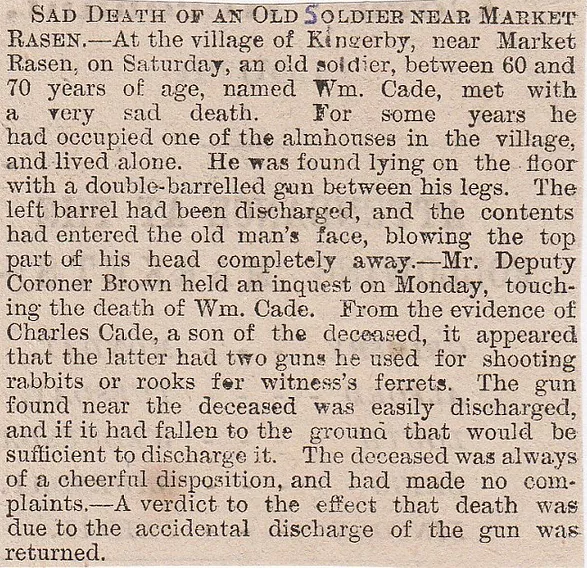
21/ Little Carlton Mill Drowning, near Louth, September 1882
The mill is still there on the Main Road, over the river. The death was that of James Oldacres Shakespear, son of Mr Shakespear of Shilton near Coventry. The child, with an older brother, was visiting the area, and both were being looked after by Miss Fawkes at the mill. The two brothers along with another boy were playing “hide and seek”, and James was missed upon the return of the other two boys. A search was made and the boys said he was last seen near the stables and they had looked everywhere. A man named Dales who worked at the mill helped in the search and even though the mill dam showed no sign of a disturbance they turned off the water wheel. When the water had nearly run off at the dam they found his body near to the stream. A verdict of “Accidentally drowned” was returned with a recommendation that the mill dam should be fenced off.
22/ Little Carlton (Louth) January 1881 (George Mawer)
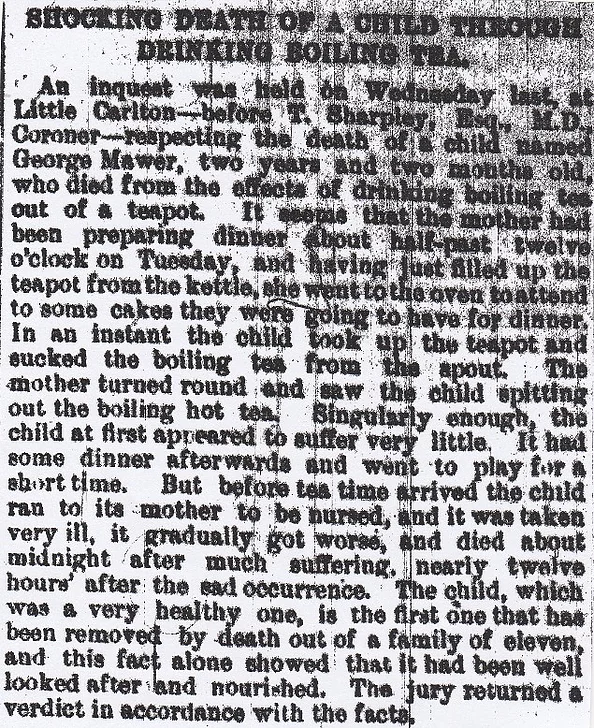
23/ Goxhill Haven Drowning, October 1874
At Goxhill on the 21st October, found drowned in the Haven, Mr Thomas Green, a blacksmith of Louth who was aged twenty-three years.
24/ Goxhill/Humber, August 1860 (Body Found)
The dead body of a man in an advanced state of decomposition and afterwards identified to be that of Thomas Rawney aged sixty-five years, a butcher from Goxhill, was picked up in the Humber. He had been missing from his house since November 29th, 1859. It was conveyed to the dead-house and at the inquest, a verdict of “Found Drowned” was returned.
25/ Goxhill ( Body Found), February 1880
The body of the unfortunate youth Charles Walker (who was accidentally drowned in Hull last week) was washed ashore at Goxhill on Monday, at a distance of several miles from the spot where the steamer Parana was lying. The body was taken back to Louth and the funeral took place at the Cemetery. Deceased was only aged sixteen years of age.
26/ Goxhill Railway Death, August 1879
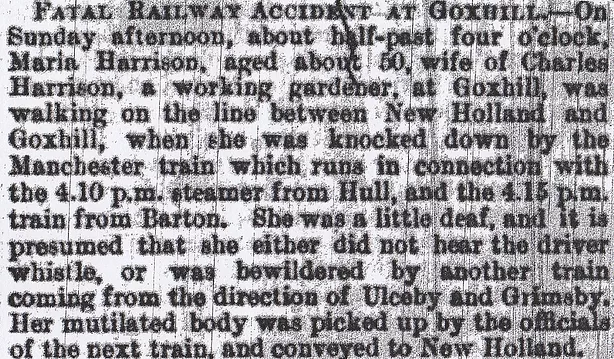
27/ Killingholme Suicide Coincidence, September 1865
A young woman named Ann Eliza Evatson committed suicide at Killingholme by cutting her throat. Deceased who up until Christmas lived at Barton, had an epileptic stroke at the time, which has latterly been repeated, so much so that the unfortunate woman has been able to earn her own living. The deceased was the illegitimate daughter of a surgeon, who on the occasion of her birth became highly excited and taking a large draught of tincture of opium, mounted his horse and rode from Ulceby to Brigg, and on arriving opposite to the Lincoln bank at Brigg, he fell dead from his horse. Just twenty-eight years from that day, and at the same hour, his natural daughter committed suicide. The same coroner who presided over her father’s inquest in 1837 also performed this one.
28/ Killingholme Haven, February 1900 (Body Washed Ashore)
On Sunday, the body of a man was found on the foreshore of the Humber near Killingholme Haven by Mr Isaac Wright. There was nothing on the body or clothes to lead to identification. An open verdict was returned.
29/ Killingholme Suicide, November 1903
Wright Cuthbert of Killingholme had told his housekeeper that he had been negotiating and sold his soul to the Devil for the next 1000 years. If I was her, I would have handed my notice in, but several days ago he hung a noose in the coach-house and told her that he was going to hang the Devil from it. He hanged himself from another noose on another section of the farm.
30/ Killingholme/Humber, (Boat Capsized) February 1899
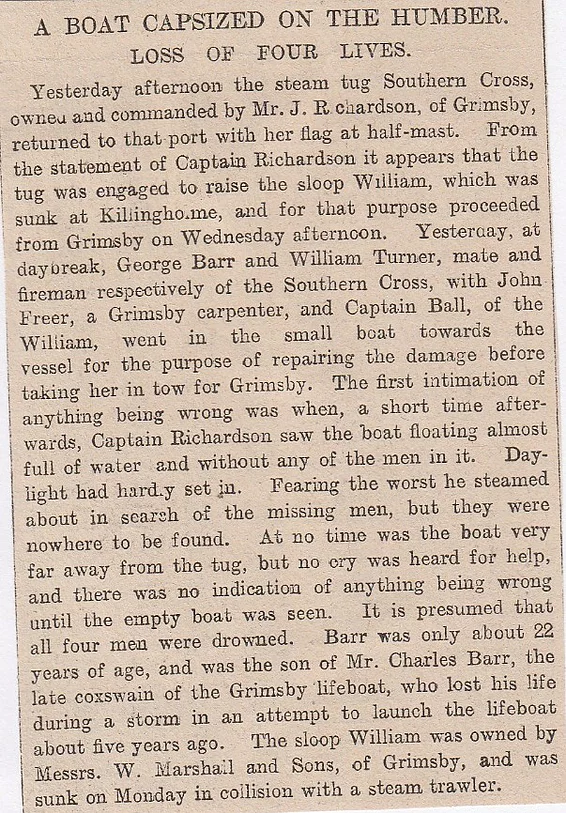
31/ Kenwick Park Lightning Fatality, June 1871
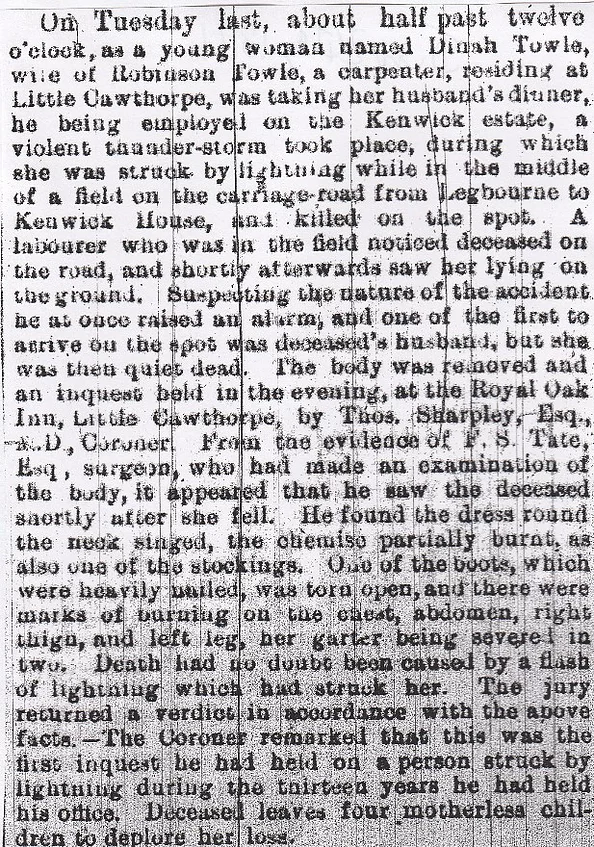
32/ Legbourne, (Criminal Did Well) August 1840
A man named Sharp who was transported to Australia twenty years ago has returned to his home village, with a sack load of cash at his disposal. He had built up a business through diligence and hard graft and now has a fortune estimated at £20,000 and is now seeking a county manor in which to reside.
33/ Legbourne Suicide, January 1886
Edward Parker aged thirty, hanged himself in his master’s out-house. Mr Barton found his servant had not come in at his usual time so went to look for him and discovered him in the out-house, hanging from the ceiling by his neck and being quite dead. The suicide was a most determined one with Parker using a piece of rope with an elaborate number of knots in it. His feet were touching the ground and the body leaning forward. Mr Barton also said that Parker had come into the yard and asked for work in September 1885, and he took him on at five shillings a week. He was a good workman, he was always punctual and believed his mother was living in Binbrook. The jury decided that the deceased strangled himself but could not tell what frame of mind he was in at the time.
34/ Legbourne Suicide, June 1877
An elderly man named Robert Baldwin, who was a labourer, and lived at the corner cottage opposite the National School, committed suicide in a shocking manner. He worked at Reston but took the day off on Monday as he felt ill, but on Thursday morning he got a piece of rope, one end of which was fastened to the top staye of the ladder leading from the lower apartment to the bedroom;at the other end he made a noose which he put around his neck, then jumped off the steps of the ladder. His wife woke up at this time, but being deaf she thought it was a door shutting as her husband went to work. Then she saw his clothes and thought there was something wrong. She climbed down the ladder and saw deceased attached to it with his head to one side. Quickly she grabbed a knife and cut him down, but he was dead. His father hung himself at Cawthorpe many years ago, and a couple of years ago his brother took his own life in the same manner, at Louth.(Next to War Memorial?)
35/ Legbourne Drowning, November 1902
The sad death of John Maw, butcher and farmer of Legbourne aged seventy-six, was found drowned in a pond on Mr Stephenson’s farm by Adelaide Ward at about 6-45 a.m. He was last seen alive at the Queen’s Head Inn, Legbourne, on Monday evening, leaving at around 9 p.m. Fifteen-year-old Adelaide spotted the body floating in the pond and ran to tell her cousin. The body was face downwards when they got a rake and fished him out, then they knew it was John Maw. It was thought that Maw had somehow accidentally fallen in and drowned. The coroner commented that the last time he was in Legbourne parish attending an inquest it was on the body of a man who was found drowned about two years ago.
36/ Linwood Suicide, April 1879
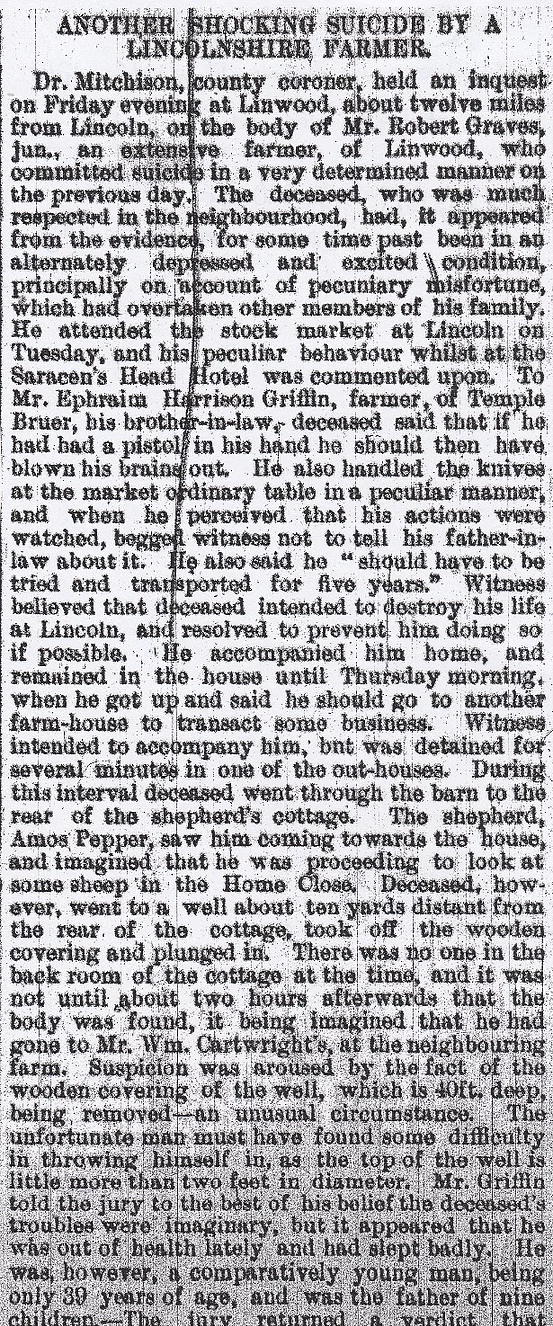
deceased drowned himself whilst in a state of unsound mind. I also have here that he died on the 10th April 1879 at Linwood Grange, Blankney.
37/ Grainthorpe Drowning, (Austen Fen), October 1875
George Motley, a farmer, was discovered drowned in the Louth and Tetney Navigation Canal. He had been to the October Fair at Louth when he imbibed too much liquor….or got ratted as we now know it. He had transacted some business with Mr Bryan of the beerhouse at Austen Fen (Where inquest was held), after which he accompanied him home from Motley’s own house. Mrs Motley became worried and sent a messenger to get him but he couldn’t be found anywhere. It was a dark night and they thought he’d fallen in the canal. On Saturday morning, Alfred Ticklepenny, with others, dragged the canal and found Motley about 600 yards north of the Austen Fen Bridge. His watch having stopped at 7-33, with all his money and bank-book in his pockets. There were no marks of violence. “Accidentally Drowned” was the verdict returned.
38/ Grainthorpe Suicide, February 1885
John Green, a retired carrier aged sixty-six, was found hanging from a baluster in his house on Saturday, quite dead. He was a widower and had a young man to live with him but he died a short time ago, and since then he has been alone. Since the death of James Odling whom he had brought up, and who attained the age of twenty-seven, deceased had been in a very depressed condition. He had also expressed fear that his money would not last. Jury’s verdict-“Suicide whilst temporarily insane”. He had been a carrier between Grainthorpe and Louth for thirty years, his cart standing in the “Pack Horse” yard in the time of Mrs French.
39/ Bricklayers Arms Suicide, Grainthorpe, March 1876
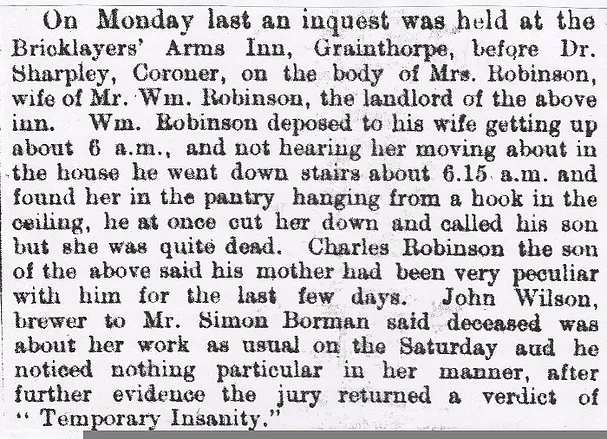
40/ Grainthorpe Suicide, August 1889
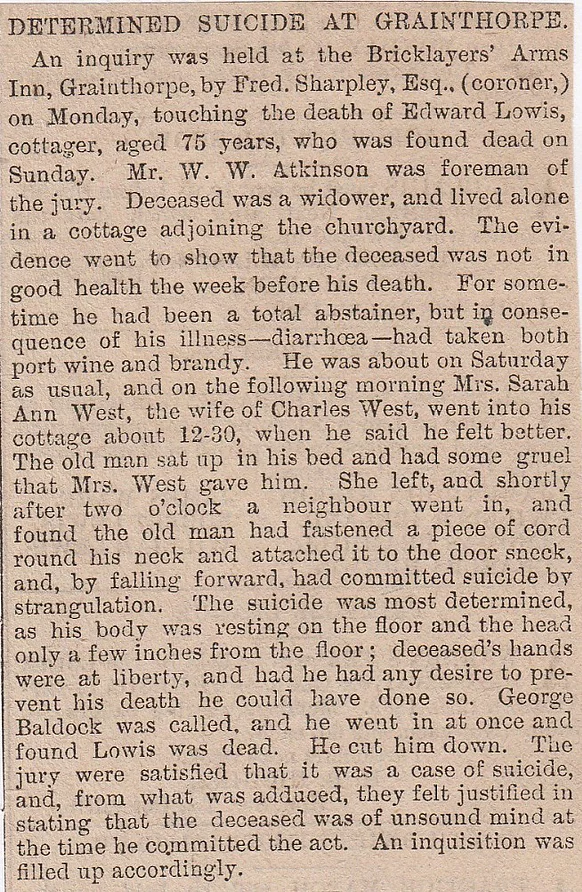
41/ Hainton Hall Fatality, (Market Rasen), June 1919
A horrendous fire nearly wiped out the whole of Hainton Hall near Market Rasen in 1919. It is the Lincolnshire seat of Lord Heneage, and the fire caused little damage to the more ancient portion of the premises but the modern wing, where the family resided, was just a charred shell. Firemen from all over the northern section of the county were called in to help douse the flames but one Grimsby fireman lost his life. The ceiling collapsed and poor Albert Bancroft was directly underneath the half a ton of rubble that fell on him. Lady Heneage was extremely distressed by the death.(Where is Albert buried?)
42/ Hainton Hall (Attempted Suicide), January 1869
On Friday the 25th December 1868, a man named Duckering, butler to W.R.Emeris Esq, of Louth, attempted suicide by cutting his throat at Hainton Hall where his master was visiting. The attempt was made in an upstairs room and when the unfortunate man was found, he was bleeding profusely. Various rumours were afloat as to the cause of such a rash act. Prompt assistance placed the man’s life out of danger and he is now slowly recovering.
43/ Gayton-le-Marsh Suicide,(Louth) July 1889

44/ Gayton-le-Marsh Murder, October 1851
This is the most feeble alibi of any murder I’ve heard of. At Gayton-le-Marsh near Louth, a witness heard a gunshot coming from the Baker’s property a few hundred yards away. It was only when the Mr Baker himself, stumbled up to his door and mumbled that his wife had been shot by an unseen assassin and that a murder had been committed, or so it seemed. A local surgeon dressed the wounds sustained by Mr Baker but found no shot in them. He told of being shot at as well, so this aroused suspicion. Baker had wanted to sell up and go to America but Mrs Baker was less keen and refused him any money to fulfil his dream of going across the pond. It seems that he shot his missus then inflicted a wound on himself to make it look as though he’d been attacked at the same time. Mrs Baker had been shot while she sat sewing in front of the fire, straight through the window. The witness only heard one shot, and lack of gun contents in his wound put pay to his weak alibi.(What happened to Mr Baker?)
45/ Ludford Magna Murder? February 1862
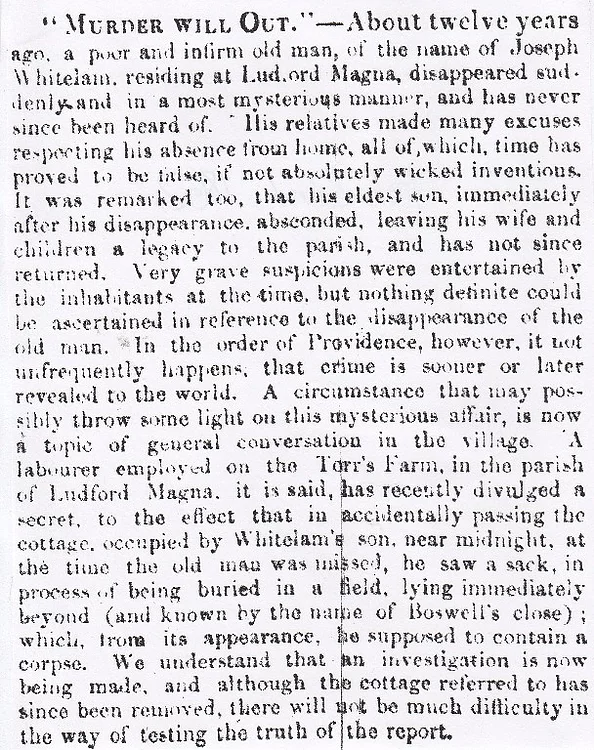
46/ White Hart Inn Death, Ludford, September 1882
A labourer named John Townsend died at the White Hart Inn at Ludford, from injuries received on the previous morning through being run over by a portable engine. Townsend worked for Luther Adams, a farmer, and at 5 a.m. he was in charge of a team of horses and a portable engine. Whilst descending the hill near Ludford the horses were overpowered by the load and ran down at full tilt. Deceased kept up for a while but stumbled and fell, with the wheels passing over his body. He clung to life for around thirty hours but then died. “Accidentally killed”.
47/ Ludford Skeleton, June 1866
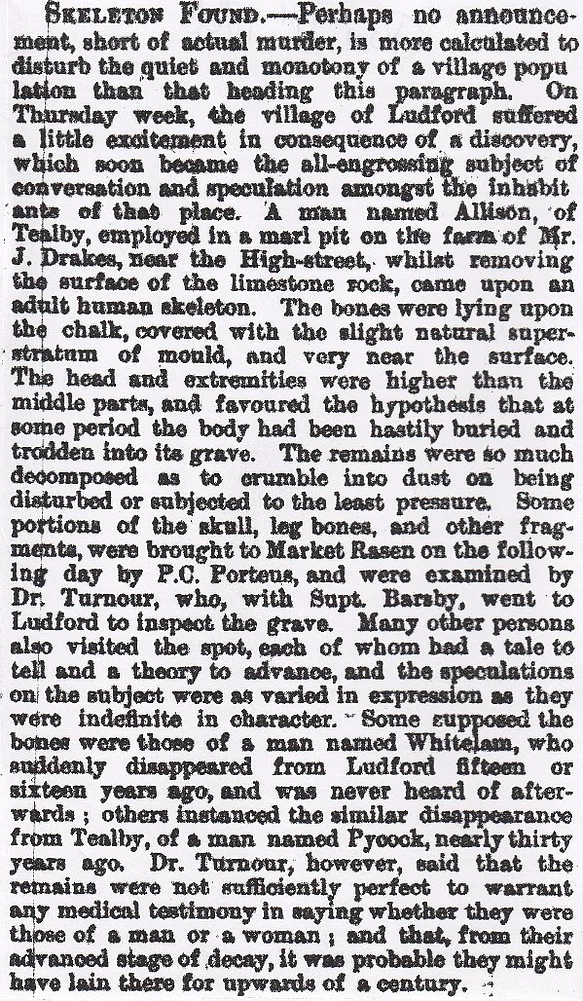
48/ Keddington, (Louth Canal) February 1875 (Body Discovered)
Charlotte Peel, the wife of John Peel an agricultural labourer, was found drowned in the Louth and Tetney Navigation Canal. She was well known in the town of Louth and known to be slightly eccentric and who was the cleaner at the Town Hall for a long time. She had recently shown symptoms of depression and was seen talking to herself on Keddington Road, then got to Alvingham and asked where the Market Place was. Her body was found by her husband in the canal in a nearly upright position near a holt in Keddington. The verdict was “Found drowned, having walked into the water accidentally”.
49/ Keddington Fatality, September 1859

50/ Kirkstead Station Fatality, (Woodhall Spa) October 1851
An accident occurred on the Great Northern Railway at Kirkstead Station near Woodhall Spa one Friday morning. An employee of the company was killed at the station owing to gross negligence on behalf of the signalman who should have been paying attention at the time.(Name?)
51/ Langton, (Horncastle) March 1869
An inquest was held at Langton on the body of Mr Christopher Coates who died on the 27th of February from the effects of a fall from his horse. He had been at Horncastle the previous evening and was returning, attended by his groom, Edward Lorrly, when he fell from his horse and sustained concussion of the brain from the effects of which he died the following morning.
52/ Little Steeping Railway Crossing Death,(Spilsby) November 1897
A forty-eight-year-old farmer named Thomas Odling, met his death at the crossing at Little Steeping near Spilsby. He was on his way home in a cart, drawn by two horses, and while waiting on the line for the gate to be opened he heard the Boston/Grimsby express hurtling towards him. He jumped off and grabbed the horses to turn them around but was hit full on and at terrific velocity. His corpse was hurled forty yards away and was badly mangled in the impact, with a horse being disembowelled, and the other having it’s spine broken. The cart fragments which were sprayed everywhere hit Mr Johnson and broke his leg. Odling leaves a widow and one daughter.
53/ Haugham Landslip Fatality, January 1866
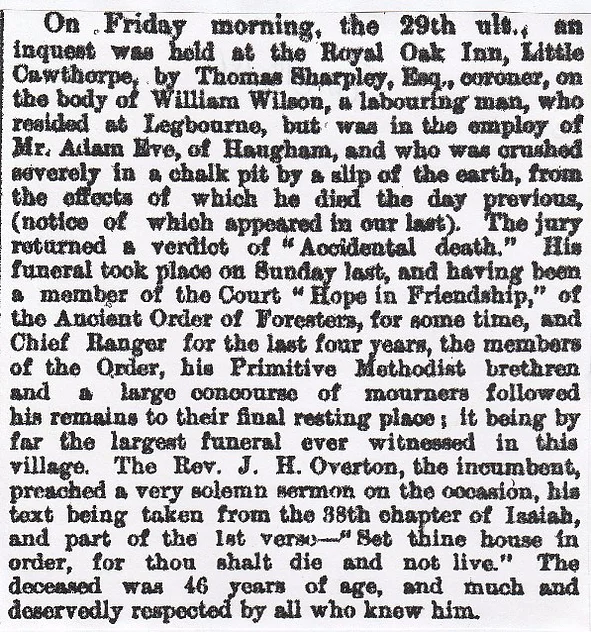
54/ Kexby, (South-East of Gainsborough) June 1880
The mother of little Thomas Thompson Leeman aged nine months, left the house for a few moments to go and feed the ducks leaving him in the charge of a four-year-old girl. The father passed the window then shortly after, heard his wife screaming. He went back to the house and found Thomas in a bucket full of hot water. The girl said the boy was looking for his father while the girl held him and got restless when he passed the window. The fidgeting boy slipped out of her grasp straight into the hot water. A doctor was sent for and tended to the scalded infant but despite this help, he died the next morning.
55/ Keadby Suicide, (On River Trent, west of Scunthorpe) October 1894
Seventy-year-old John Winter was discovered hanging in a warehouse, but the reason for this man’s suicide is a singular one indeed. He was contracted to keep the drains clear but recent high tides had blocked them, and in the old man’s mind, he hadn’t done his job properly, so killed himself as a result.
56/ Keadby/Burton Stather Drownings, July 1876
Two lives were lost in a tragic accident on the River Trent somewhere between Keadby and Burton Stather. The sloop “Eagle” is being repaired at Burton Stather, and on Sunday, Captain Barnett Brooks, along with his six-year-old son, and a carpenter, headed up the river towards Keadby Bridge. They set sail and all was going well when they approached Keadby, a gusty wind blew the vessel over, with all three precipitated into the Trent. The carpenter being a good swimmer, managed to get ashore but the captain and his young son drowned.
57/ Gunness, (Scunthorpe) August 1905
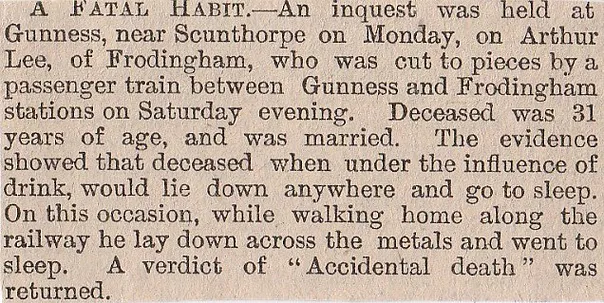
58/ Goulceby Drowning, May 1867
Goulceby’s most famous inhabitant was William Marwood the hangman, who was born here and went on to invent the “long-drop” method of execution. This one, however, doesn’t involve him. The mill-dam at Ranby near Goulceby was the scene of an awful accident, where Thomas Stothard the 54-year-old miller had left East’s public-house at Goulceby and was hardly able to stand up with the amount of liquor he’d consumed. He stopped at Sylvester’s cottage and asked him to make sure he got home alright, but he thought he was perfectly capable of getting home on his own. Next time he was seen they were lifting his body out the mill-dam at Ranby.
59/ Goulceby Exhumation, August 1860

60/ Hackthorne Hall Shooting Fatality, (Lincoln), January 1862
Captain Tennant R.N., was killed in a fearful shooting accident at Hackthorne Hall. A party of Weston Cracroft Amcotts, the High Sheriff of Lincolnshire, and Captain Cracroft R.N., along with Captain Tennant, who was married to Cracroft’s daughter; the Reverend Robert Cracroft, and the Reverend E.G.Jarvis, plus some others, were at Hackthorne Hall on a pheasant shoot. During the fun and games, a pheasant flew up and Captain Cracroft shot it. Captain Tennant had dipped down to allow him to get a good aim and Cracroft totally missed the bird and blew away Tennant, taking off the top of his head. The body was removed to the Hall and the Reverend Cracroft went to Canwick Hall to break the bad news to Mrs Tennant who was staying with her sister, Mrs Sibthorp. “Accidental Death” was the verdict.
61/ Greetham Suicide, (Horncastle) May 1879
John Hobson, a young farmer aged twenty-five and from Greetham, shot himself whilst in an unsound state of mind. The coroner was attending the third suicide in this district within the past nine days. Hobson lived with his mother, brother and sister, with his mother being infirm and virtually bedridden. The brother went to bed one night and left Hobson and his sister sitting up. They followed soon after when a few moments later they heard Hobson go downstairs. She asked him where he was going and he replied that he thought he heard a disturbance and would check it out. When he returned to bed, a man knocked on the window and spoke to the younger brother, and the stranger went away. That night a gun report was heard at one a.m., and Hobson was found drenched in blood with a large hole in his chest. He never said a word and death must have been instant. The father died at Christmas time and he had been despondent ever since then.
62/ Harrington Fatal Accident, May 1876
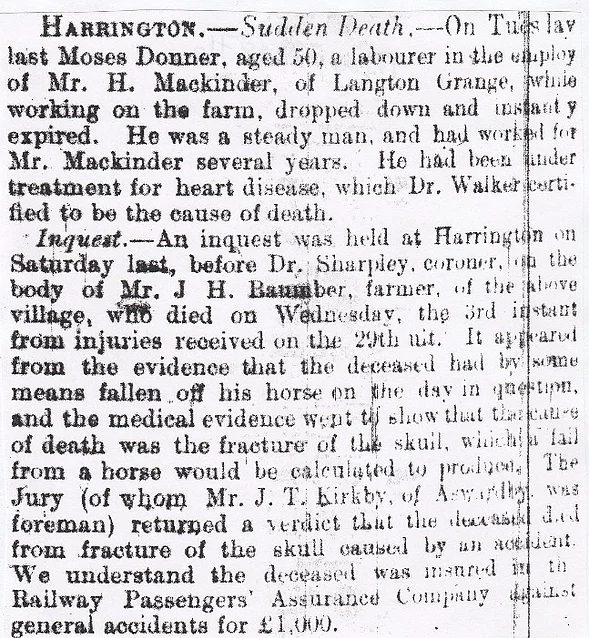
63/ Halton Holegate, September 1897 (Farm Haunting)
Human bones were found underneath a brick floor of a farmhouse near Halton Holegate. A spectral figure has been seen and odd knocking and tapping had been heard. The farm stands back from the road and is occupied by Mr and Mrs Wilson and a servant. Mrs Wilson spoke of the haunting, saying:
“We came here on Lady Day. The first night we heard strange noises about midnight, as though someone was knocking on the doors and walls. Once it seemed as though someone was moving all the things about in a hurry downstairs. Another time, the noise was like a heavy picture falling off the wall. In the morning I found everything as right as it should be. The servant left saying he dared not stop and we got another. About six weeks ago I saw “something”. Before getting into bed, my husband having retired before me, I thought I’d go downstairs and see if the cow was alright as it was about to calve. I did so, when at the foot of the stairs, just as I was about to go up again I saw an old man standing at the top looking at me. He was round-shouldered. How I got past I cannot say, I darted to the bedroom and slammed the door. Then I went to the dressing table to get some water but feeling somebody was behind me I turned around and again, there stood the old man. He quickly vanished, I have seen him several times since though not as distinctly.” She took the interviewer to the room where these occurrences happened and it was noted that the floor in one corner was very uneven, and a day or two ago Mrs Wilson took up the bricks and intended to relay them. There was a horrible smell when she did this and her husband found three bones, a gold ring and pieces of black silk. They were buried in quicklime. A doctor examined the bones and stated they were human and over a century old.
64/ Halton Holegate Suicide, April 1888
On Friday morning, the 6th of April, about 4-30, William Searby, aged sixty, of Halton Fenside, was missed by his wife, who, on searching for him, found him in the bedroom suspended by a cord around his neck, The cord being attached to a nail in the wall. Mrs Searby called for help and a neighbour came and cut him down, but life was extinct. Deceased had been in a despondent state for some time.
65/ Halton Holegate Gun Accident, September 1884

Sorry, this bottom piece is missing!
66/ Hogsthorpe Suicide, January 1888
Isabella Carden aged fifty-two, was attended by Dr Pockett for sunstroke in July and since that time had been in a depressed state of mind. The husband said he left the house for about fifteen minutes on Wednesday and when he came back, she was hanging by the neck with a chain which she had secured to the damper of a large oven, which was formerly used as a bake oven. He took her down but he was too late to save her. Deceased was buried on Sunday afternoon. (At Hogsthorpe?)
67/ Hogsthorpe Fatal Accident, July 1885
A distressing accident happened to the five-year-old son of Edward Dring on Saturday the 4th July. The father is a carrier between Hogsthorpe and Louth and he had brought home several hundredweights of goods for various tradesmen in the place, and having left his cart standing in the yard with the shafts resting on the usual prop sticks, the deceased, along with other kids, started swinging on the back of it. This caused it to topple over crushing the boy’s head in a frightful manner. All of Dr Boulton’s skill proved to be of no avail and he succumbed to the injuries he received. “Accidental Death”.
68/ Hogsthorpe Female Suicide, March 1892
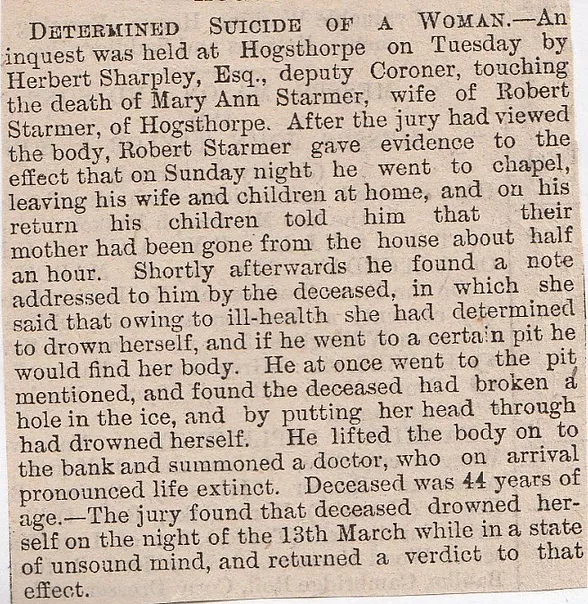
69/ Hogsthorpe Child Murder? April 1888
The body of a newly-born child was found in a pit in the brick-field at Hogsthorpe. The male baby was found in a pond of water one Monday morning and the circumstances into its demise, look suspicious. It was covered in paper and it had been in the water for quite a length of time, and a post-mortem examination would determine if the child had a separate existence. William Parrinder noticed a pike floating on the pond then went back to get it later on but was unable to reach it. He used the boat at the side and rowed out to get it and then noticed what he thought was a duck that had been shot. He uncovered the paper, and saw the child and immediately went to inform the police. It weighed six pounds and was twenty-one inches in height, with the cord not having been tied. The body had been in the pond for some months. The skull was not broken and the brain was like cream, The lungs would not float in water which points to strong evidence against a live birth. It had three bruises, two on the forehead and one at the back of its neck. An open verdict was returned.
70/ Hogsthorpe, (Body In a Ditch) December 1886
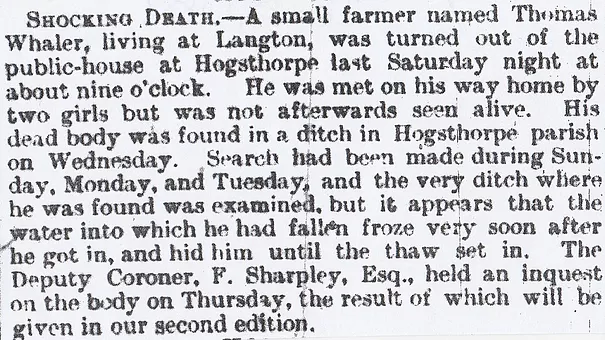
71/ Horkstow near Barton, September 1847 (Inhuman Treatment)
An Irishman named Kane had been helping with the harvest for Mr Spencer, a local farmer at Horkstow. Kane had a wife and six children to take care of, and four of them, as well as the mother, had a serious fever. The poor woman was pregnant on top of everything else, and she wanted Kane to ask Mr Spencer if they could stay in an outbuilding. Spencer in no uncertain terms told them they couldn’t, and was going to pay Spencer for services rendered, only until the whole lot of them got off his property. He pleaded for a cart but was flatly told that he had none. They managed to walk to South Ferriby and in her condition, it was a minor miracle. She gave birth in a public street and was given the barn she desperately craved but far too late. The child died through lack of a medical man being present and with all this, the mother was in a delirious state. The inquest ascertained that the family, especially the woman, had suffered inhuman treatment and those responsible should be ashamed of their conduct towards them.
72/ Horkstow Bridge Triple Death, March 1899
Two children named Emma Hildreth aged three and a half, and Frank Hildreth aged two and a half, were playing on the river bank and fell in. The mother went to save them and jumped into the Ancholme, she too was a poor swimmer and failed to grasp hold of them. All three were drowned together. The corpses were recovered from the river, but each one was lifeless.
73/ Kirton Lindsey Station Decapitation, February 1879
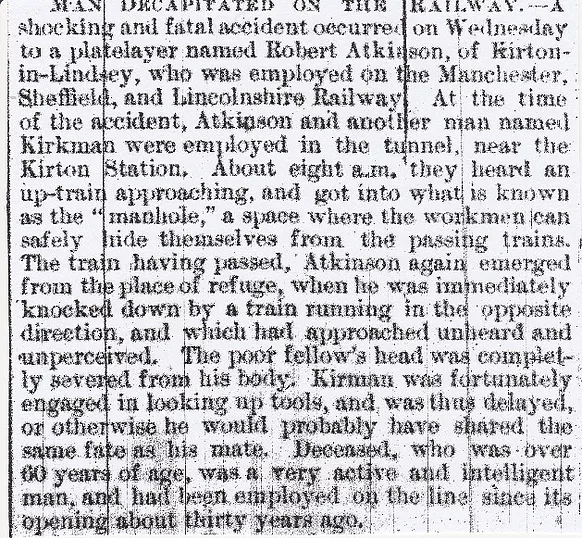
74/ Snitterby Child Murder, near Kirton Lindsey, October 1881
At the Brigg Police Court, Mary Jenny aged thirty-eight, a widow from Snitterby near Kirton Lindsey, was charged with the murder of her infant child. The dead body of prisoner’s newly born child was found in a bucket, three quarter’s filled with water. The prisoner had stated to P.C. Saunders, that she was sorry she had done it. The prisoner was committed for trial at the Nottingham Assizes.
75/ Kirton Lindsey Double Murder, December 1836
William Marshall was the male half of the brother and sister team that lived together in Kirton Lindsey, with Deborah Elizabeth Hutchinson, the other half. They were frugal and kept themselves to themselves. This gets tongues wagging and the theory that they had money under the floor-boards. Two charwomen, Elizabeth Beech and Rosamund Sampson worked for the pair and usually did an 8-5 shift. They spotted a suspicious looking man hanging around when they left the evening before and asked if he could buy some vegetables from them, as the brother/sister did sell their garden produce. They described him as average height, smoking a pipe, and having an Irish accent. Beech went to work one day, did her chores, then left as usual at around five o’clock, and when she came the next day that’s when she saw the horrific murder scene. Mrs Hutchinson was under some bags with her head smashed in and an eye socket devoid an eye, her jaw broken, and a fractured skull. There was blood everywhere. Next, she saw the corpse of her brother, William Marshall, who sustained a broken nose, a wound that exposed the brain in his skull and was drenched in blood. The murderer had put the woman’s clothes over the window to prevent people seeing what was going on inside and then robbed them of all they had, including money and silverware. The two charwomen said the man who they had seen hanging about, looked like John Dimsey who lived there a number of months ago but left Kirton Lindsey. The jury thought it was a case of “murder by person or persons unknown”. (Was it Dimsey?)
76/ Kirton Lindsey Murder, December 1847
Two labourers found the body of a male on the way to Kirton chapel, coming from Blyborough. About a mile outside of the village, they found him with a dog lying next to it. He had his throat slit and had been punched and kicked. He was identified as Charles Copeman, a 26-year-old farmer from Blyborough and had been to the fair at Kirton, had a few jars then walked home. His bull terrier had cuts on it and his pockets had been rifled.
January 1848
A man named Travis, accused of Copeman’s murder was committed to Lincoln Castle. Weirdly, a friend of Copeman’s, Mr Whelpton, had a dream about the murder and saw him attacked in his dream. He warned him not to go out late at night. He said he would comply but ignored it and then was murdered. Edward Landseer, the artist, wanted to own the faithful hound that stood by his master. Did he?
77/ Grayingham Suicide, near Kirton Lindsey, August 1882

78/ Haxey, November 1861 (Child Shot by Brother)
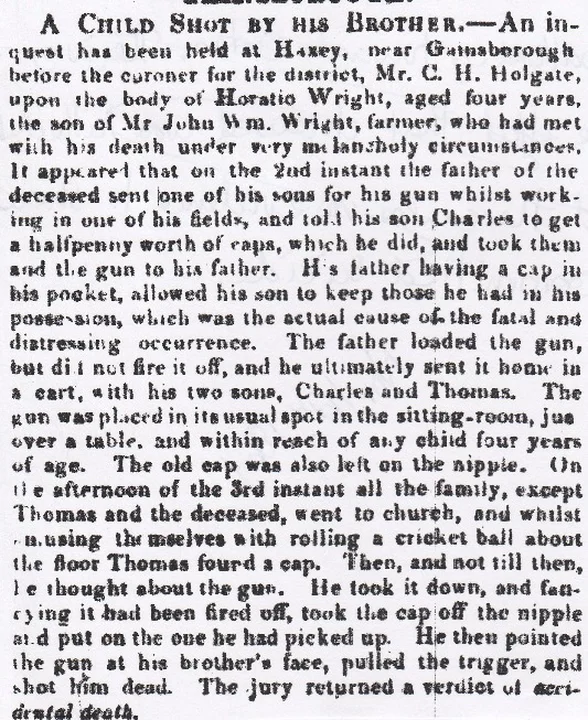
79/ Westwoodside, (Haxey Murders) July 1861

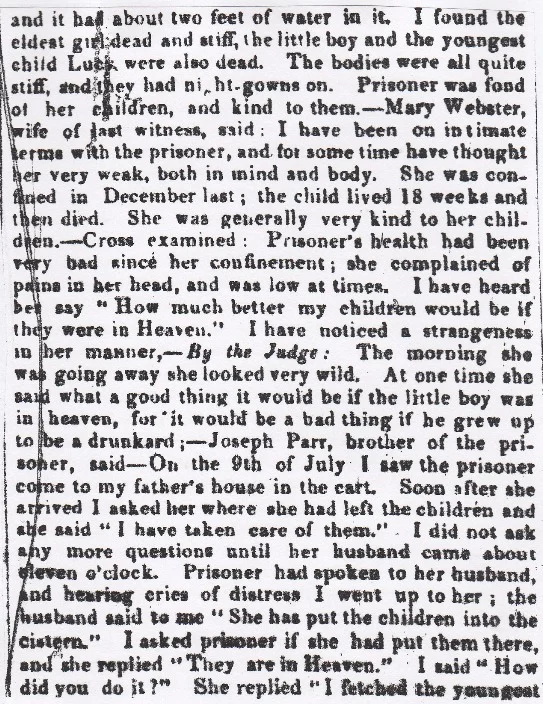
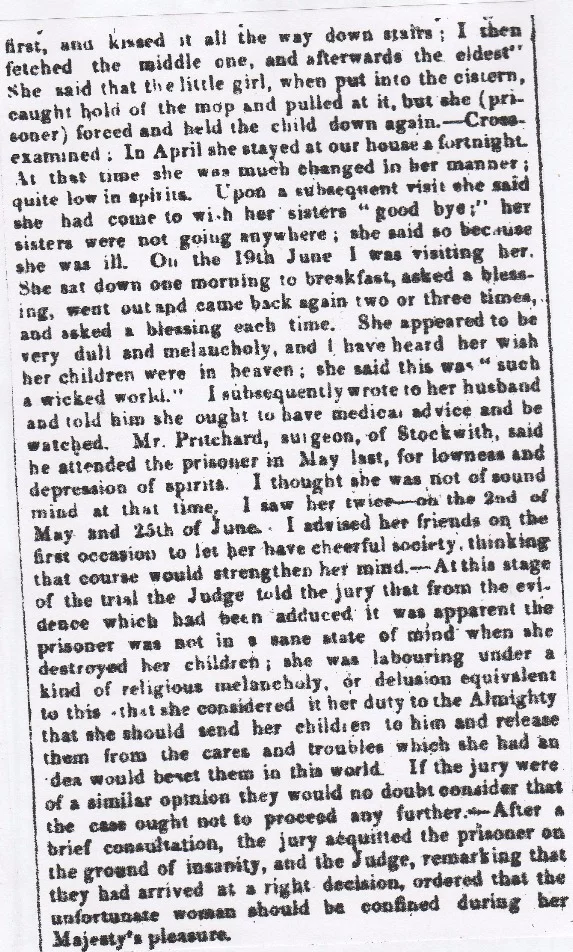
80/ Ingleby Corpse, (Lincoln) January 1843
The dead body of Mr Parker was found in a field next to Ingleby church, with his pockets having been rifled and suspicions of murder, just after Boxing day in 1842. Mr Evison, a shepherd, was on the path in the field next to the church when he saw Mr Parker lying on his back, groaning. He asked his name but received no reply so he went for help. When several people followed him they identified the body as that of Mr Parker. He had been beaten up and robbed of his cash. Joseph Atkinson, a horsebreaker who resides in Lincoln, sat down with Parker the night before and said he left him to go to church and next time he heard his name mentioned it was concerning the dead body they’d found.(Did they get the killer?) In the 1882 White’s Directory, I found a John Parker living in Ingleby. Was it his son perhaps?
81/ Ingoldmells Drownings, (Skegness) August 1853
Two of the son’s of Mr Childs of Moorgate, London, who is the surgeon in chief to the City Police Force, were drowned on the coast at Ingoldmells north of Skegness. The two lads, aged nine and ten, were swimming in the sea (North Sea) and were told about the large holes where clay had been dug up and to watch out for them. The governess had taken the two girls for a paddle on the beach with the boys nearby. The governess took the girls back to the hotel, and the boys were going to follow or so she thought! They got to the hotel and an alarm was raised, that two lads were in trouble. Mrs Childs, dressed in her nightie, ran down to the water’s edge and strode into the water. Onlookers pulled her back. John had sunk without a trace but Julian was floating on the surface, both drowned. A verdict of “Accidental Death”.
82/ Ingoldmells Poisoning, July 1882
A man named Deans bought some rat-poison which he placed safely in a spice-box, which he then put in the clock case in the kitchen to keep out of the reach of the kids. They had a nurse, named Blake, who was making a pudding one day and found the powder which was arsenic and popped it in the cake assuming it was baking powder. Deans and the two kids ate some of the pudding but said it tasted funny. She said it must be the baking powder from the clock case Deans shot up, yelling out that that was poison and went to get assistance. A neighbour gave them mustard emetics (makes you vomit), and they all survived. Mrs Blake had nearly killed three people and this preyed on her mind for some time after, so much so, that she expired shortly afterwards.
83/ Huttoft Lightning Fatality, September 1880
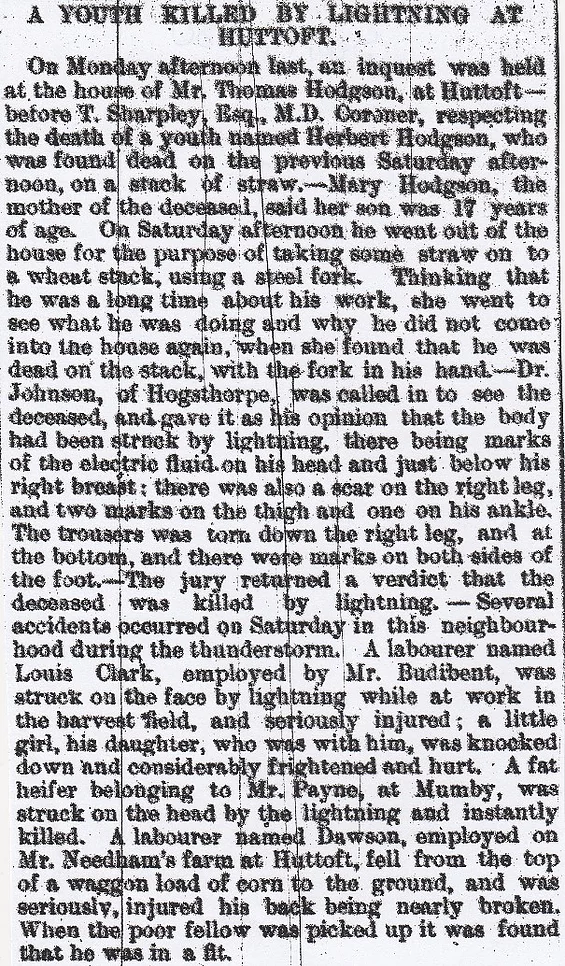
84/ Huttoft, November 1883 (Childs Body Found)
Florence Mary Wilkinson the infant daughter of Henry Raithby Wilkinson went missing at 10-30 a.m. on November the 15th, just after Mrs Wilkinson had got her dressed. It was meant to be with the grandad in the garden but wasn’t. A frantic search around the area revealed the child to be in a ditch, in which it had fallen head first and had drowned.
85/ Near Huttoft, December 1877 (Body Washed Ashore)
The body of 14-year-old William Baylis, who was the fisher-boy on the smack “Onward”, which was owned by John Oliver Hawkes from Grimsby, and was recently wrecked off Theddlethorpe in the gale. The captain and crew were compelled to abandon their vessel and took to the small lifeboat but during their struggle to shore, the boy was washed away by a heavy sea and lost. The body went ashore on the Huttoft coast and was discovered by Henry Scown, a coastguard.
86/ Huttoft Death, September 1878
Frederick Parish, a wholesale grocer from Gainsborough whose dead body was found in the Huttoft drain by Susannah Hodgson. Deceased and his missus were visiting Huttoft and were staying with Mr Robinson, a farmer. Parish woke early one morning and complained of feeling ill and decided to go for a walk to clear his lungs. He went towards Anderby, and in going there would have crossed the drain that divided Huttoft and Anderby, over which there is a footbridge, well, a plank of wood, with a railing on one side! Along came Susannah and observed a body of a male floating in the ditch. He was pulled out of the water and found to be quite dead. His watch had stopped at 9-50 a.m. It is believed that the deceased fell into the drain while in a state of syncope (loss of consciousness, due to low blood pressure).
87/ Huttoft Fatal Accident, September 1883
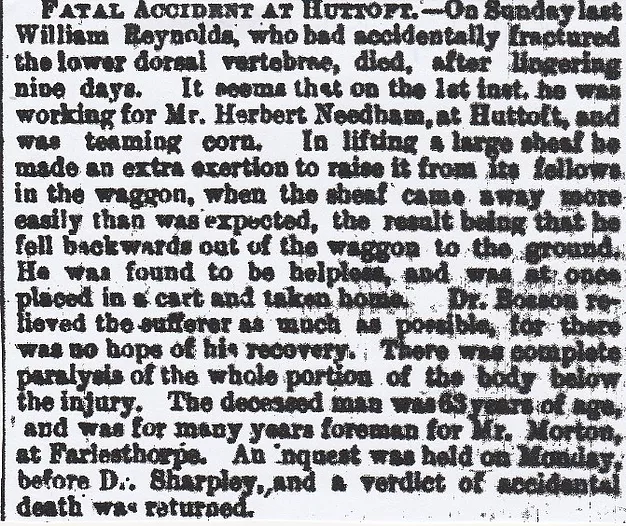
88/ Holton Beckering Suicide, December 1927
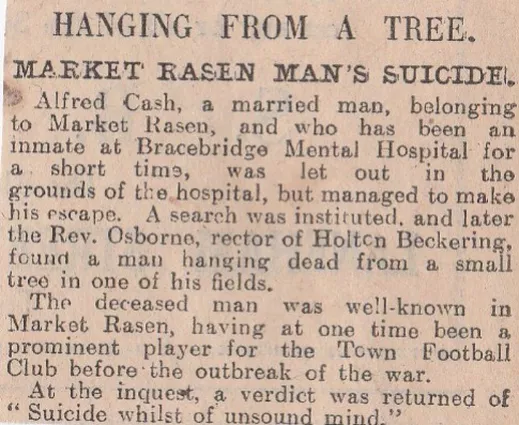
89/ Keelby Poisoning, August 25th, 1860
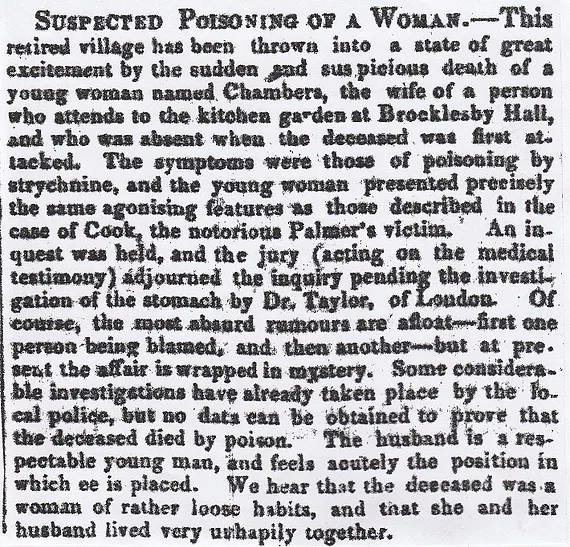
September 1st, 1860
Dr Alfred Taylor from Guy’s Hospital, London, is busy investigating the case of a young wife named Chambers, who suddenly died at Keelby a few days since. It bears all the hallmarks of strychnine poisoning.
September 8th, 1860
The adjourned inquest on the body of Matilda Chambers was held and the verdict returned was that “Deceased died of strychnine poisoning, but how it was administered, there is no evidence to show”.
90/ Hemingby Child Murder, May 1880
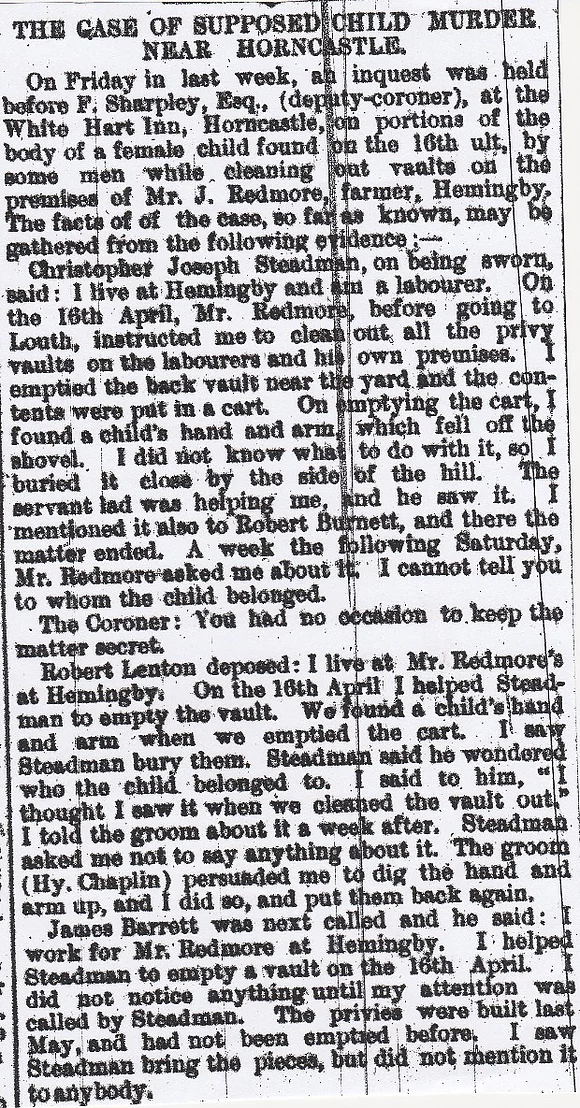
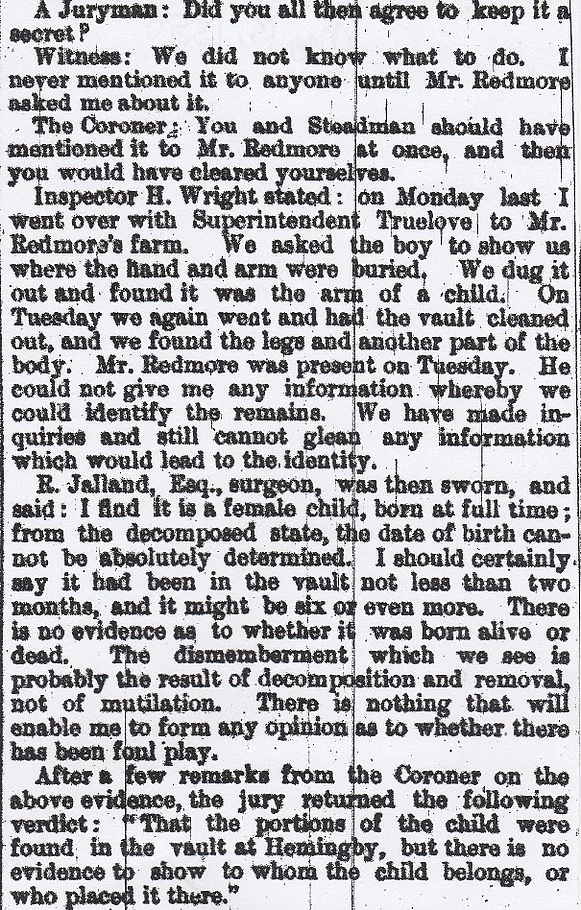
Looked in 1882 Whites Directory and found “John Redmore, farmer, The Grove.” That is down Horsemoor Lane in Hemingby and that is still there.

